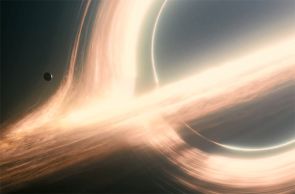
Explore Black Holes Up Close: New Visual Innovations Unveiled

A black hole as depicted in the movie "Interstellar."
(Image: Paramount Pictures)
What does a black hole look like up close?
When the sci-fi movie “Interstellar” — hitting theaters this week — wows audiences with its computer-generated views of one of most enigmatic and fascinating phenomena in the universe, University of Arizona astrophysicists Chi-kwan Chan, Dimitrios Psaltis and Feryal Ozel are likely to nod appreciatively and say something like, “Meh, that looks nice, but check out what we've got.”
“We want to know what happens near extremely compact objects such as black holes and neutron stars,” said Psaltis, a professor of astronomy and physics in the UA's Department of Astronomy and Steward Observatory. “We want to watch as matter fed onto a black hole crosses the event horizon, the point of no return, and disappears.”
To find answers, the group created a monster in the basement of the UA's high-performance computing facility. Harnessing the power of the UA's new supercomputer — nicknamed El Gato — the researchers combined knowledge from mathematical equations and astronomical observations to generate visualizations of an object known by astronomers as Sagittarius A* (“Sagittarius A star”), a supermassive black hole comprising the mass of 4.3 million suns.
Located 26,000 light-years from Earth at the center of our galaxy, Sagittarius A* is tiny to the eyes of astronomers. Smaller than Mercury’s orbit around the sun, it appears about the same size as a grapefruit on the moon.
The team just published the first major science results obtained using El Gato's unique, massive, parallel-computing capabilities to create visualizations of what a space traveler might see upon approaching SgrA*. The results, published in two reports in the Astrophysical Journal — one focusing on the imaging and the other on the computing — provide some of the groundwork for the Event Horizon Telescope, or EHT, a huge undertaking involving scientists and observatories around the world to take the first-ever picture of SgrA*.
The film “Interstellar,” starring Matthew McConaughey and Anne Hathaway, prominently features a black hole, touted as the first visual depictions based on the actual science and mathematics of Einstein's Theory of General Relativity. On some of the renderings, a special-effects team of about 30 experts reportedly spent up to 100 hours of running calculations to create each frame.
“Our team of four here at the UA can produce visuals of a black hole that are more scientifically accurate in a few seconds,” said Ozel, also a professor of astronomy and physics at Steward Observatory.
“It's a bit like gaming on steroids,” she explained. “El Gato uses a massively parallel architecture of hundreds of graphic processors working side by side, with each node functioning as a renderer in real time.”
As part of a collaboration that includes the papers' first author, postdoctoral fellow Chan, and researchers at Harvard University and MIT, the husband-and-wife research team of Psaltis and Ozel developed software algorithms capable of calculating the paths of millions of individual photons in mere seconds as they shoot toward the black hole.
Funded by the National Science Foundation and NASA, the computer simulations are a crucial step before astronomers can start to look for the black hole using the EHT, functioning as a sort of field ID guide of what astronomers should look for once the EHT is up and running.
The EHT will combine radio telescopes across the globe to create a virtual telescope the size of the Earth. These include the UA's Arizona Radio Observatory as well as the South Pole Telescope, outfitted with new receivers built by a group led by UA assistant professor of astronomy Daniel Marrone.
“We wouldn't be able to observe a black hole against a black sky,” Ozel said. “Therefore, we look for other telltale signatures telling us about the presence of a black hole.”
The gravitational field around a black hole is so immense that it swallows everything in its reach. Not even light can escape its grip. For that reason, black holes are just that: They emit no light whatsoever, and their “nothingness” blends into the black void of the universe.
As matter comes under the black hole's spell of extreme gravity, a cosmic traffic jam ensues, in which gas swirls around it like water circling a drain. As matter compresses, the resulting friction turns it into plasma heated to a billion degrees or more, causing it to “glow” — and radiate energy that astronomers can detect here on Earth.
“Our visualizations show there is a place where photons linger and form a ring outlining the shadow of the black hole,” Psaltis said. “That ring of light makes the black hole easier to find than if we were looking for complete blackness. These simulations also help us find ways to distinguish this signature from all this swirling plasma around the black hole.”
By imaging the glow of matter swirling around the black hole before it goes over the edge and plunges into the abyss of space and time, scientists can see only the outline of the black hole, also called its shadow.
In addition to providing groundwork for the EHT, the simulations will support NICER, a new NASA mission involving an instrument that will be attached to the International Space Station, to help scientists better understand neutron stars and to test navigation methods for future spacecraft using neutron stars as extremely accurate clocks.
Until EHT is ready to take the first images of what lurks at the center of our Milky Way, astrophysicists will have to get by with gaming on steroids — or going to the movies.
Contacts
Feryal Ozel
520-621-7096
fozel@email.arizona.edu(link sends e-mail)
Dimitrios Psaltis
520-621-7859
dpsaltis@email.arizona.edu












